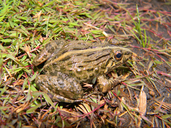|
Minervarya greenii (Boulenger, 1905)
Sri Lanka Paddy Field Frog | family: Dicroglossidae subfamily: Dicroglossinae genus: Minervarya |
 © 2011 Champika Sandaruwan Holiya Bandara (1 of 2) |
|
|
|
Description Colour of dorsum is green with dark spots and with a yellow mid-vertebral band. Belly whitish-yellow. Vocal sacs and throat speckled with grey. Paddy Field Frog belongs to the Fejervarya limnocharis group and is distinguished from F. limnocharis by its longer fingers and toes, less webbing between the toes, and uninterrupted longitudinal ridges on the dorsum. The tadpoles of Fejervarya greenii differ from those of Fejervarya limnocharis by having a dark pigmented tail fin. Distribution and Habitat Country distribution from AmphibiaWeb's database: Sri Lanka
Endemic to Sri Lanka. A montane species, having been recorded at altitudes above 1700 m asl in the central hills. This frog can be found in margins of shallow, slow-flowing streams, and under grass tussocks in marshes and small water holes. Life History, Abundance, Activity, and Special Behaviors In the Horton Plains, a large breeding aggregation of about 20-30 specimens was observed. I found Paddy Field Frog in open ponds in Hakgala Botanical Garden swimming and barking at the surface in daytime. Juveniles of SVL 13-19,6 mm were observed on 19 March 1994 and of SVL 19,4-22,6 mm on 10 August 1995 at the Horton Plains and at Ohiya. Also, I found Paddy Field Frog in Hakgala Botanical Garden. (pers. comm., P. Janzen) Possible reasons for amphibian decline Local pesticides, fertilizers, and pollutants
References
De Silva, A., Molur, S., and Walker, S. (2000). CAMP Report for Amphibians and Reptiles of Sri Lanka. Conservation Breeding Specialist Group, Sri Lanka, Colombo, Sri Lanka. Dutta, S.K. and Manamendra-Arachchi, K. (1996). The Amphibian Fauna of Sri Lanka. Wildlife Heritage Trust of Sri Lanka, Colombo, Sri Lanka. Manamendra-Arachchi, K. (2000). ''Know your frog.'' Sri Lanka Nature, 2(5), 4-16. Originally submitted by: peter Janzen (first posted 2000-09-08) Edited by: Peter Janzen (2021-11-10) Species Account Citation: AmphibiaWeb 2021 Minervarya greenii: Sri Lanka Paddy Field Frog <https://amphibiaweb.org/species/4756> University of California, Berkeley, CA, USA. Accessed Apr 19, 2024.
Feedback or comments about this page.
Citation: AmphibiaWeb. 2024. <https://amphibiaweb.org> University of California, Berkeley, CA, USA. Accessed 19 Apr 2024. AmphibiaWeb's policy on data use. |




 Map of Life
Map of Life